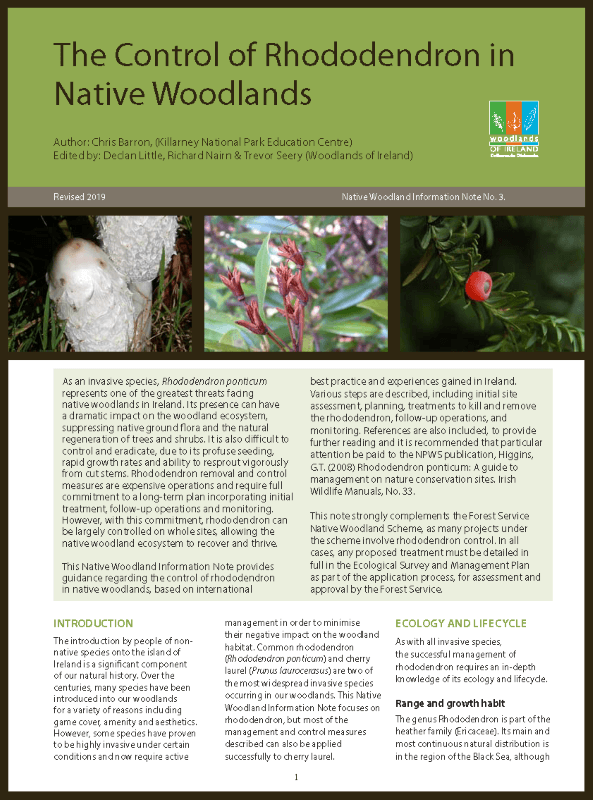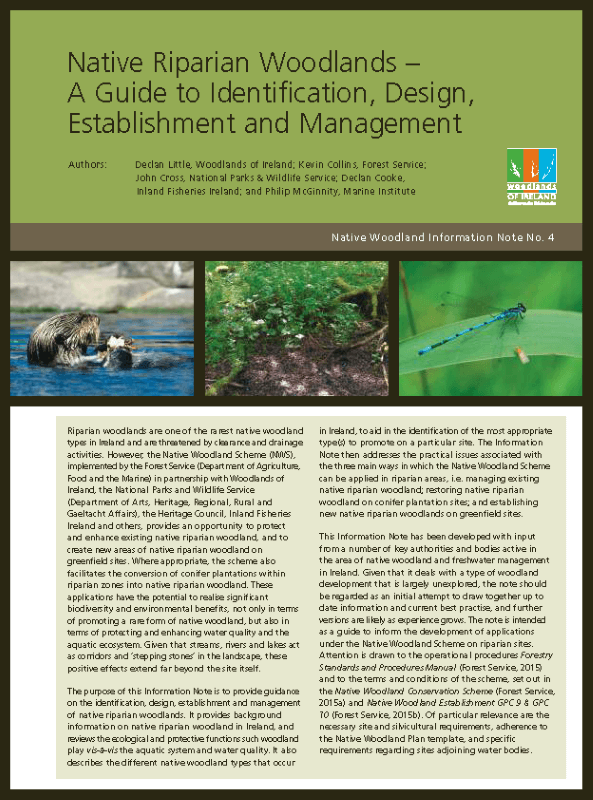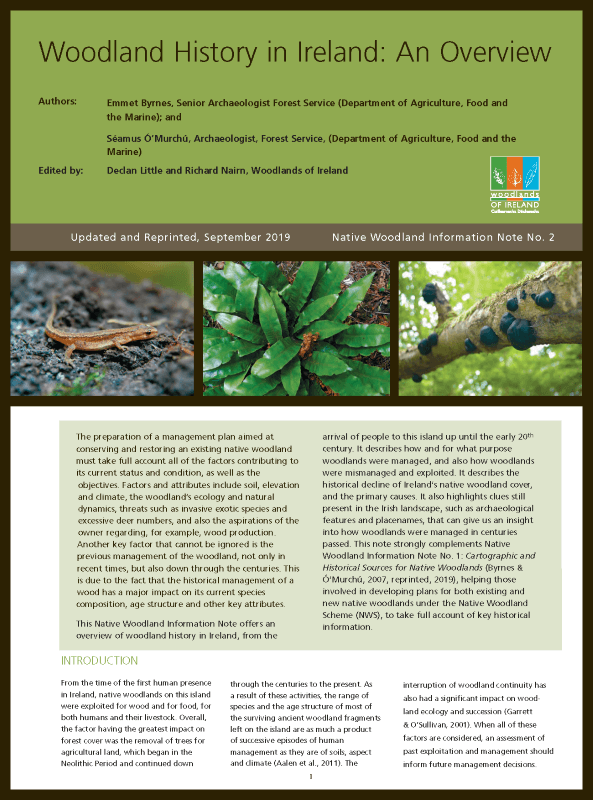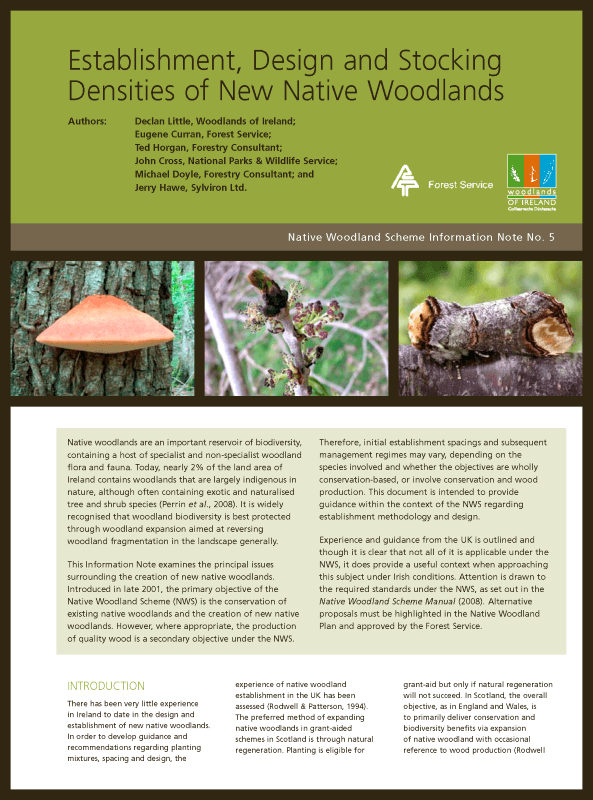In support of the Native Woodland Conservation Scheme
The first eight in a series of technical bulletins focused on establishing and managing native woodlands. The native woodland information notes complement the latest Native Woodland Conservation Scheme 2023-2027. When you enroll in the Native Woodland Scheme training course(s), these information notes come in an attractive A4 ring binder folder and are available free of charge. Subsequent notes – which will be published on an ongoing basis – will be automatically sent to those already in receipt of a folder. Each of these information notes is available to download in PDF form by clicking on the text or images below. All research and data contained in the information notes are up to date at the time of compilation. Information notes will be updated as more relevant data, techniques and research comes to light. The information contained in the notes is of a high quality and an essential resource for foresters, ecologists, landowners and anyone interested or working in the establishment or conservation of the native woodlands of Ireland. You can download and share these information notes for educational or research purposes in tandem with our ever-growing publications catalogue.
If you would like to be added to the waiting list for upcoming NWC training days please email info@woodlandsofireland.com with your name, location, and contact number.
Please read an excerpt from one of our former chairman’s statements as an introduction to the Native Woodland Scheme training course. You can read the statement in full at this downloadable PDF HERE.
Chairman’s Statement – An Introduction to the Native Woodland Scheme
“Since the establishment of Woodlands of Ireland in 1998, a wealth of practice, expertise, and knowledge has been generated in relation to native woodland ecology and management in Ireland. Much of this has arisen through the experiences of the People’s Millennium Forests Project and the Forest Service Native Woodland Scheme, launched in 2000 and 2001 respectively. This has resulted in the development of a solid foundation for the rejuvenation and expansion of native woodlands, a long-neglected cornerstone of our heritage, through active management with substantial financial backing”…. “These notes to be released periodically, will accumulate to form an invaluable ‘decision-support’ library for landowners, ecologists and foresters and others involved with the Native Woodland Scheme, and with native woodlands in general. Given that the establishment and management of native woodlands require considerable input and attention to detail, it is clear that, over time, this collection of Native Woodland Information Notes will contribute enormously to the rejuvenation and expansion of Ireland’s native woodland heritage.”
Michael Starrett, Chairman,
Woodlands of Ireland,
Coillearnacha Dúchasacha,
December 2006
(1) Cartographic and Historical Sources for Native Woodlands
“Developing a picture of how a particular site has changed down through the centuries is a key component of any native woodland project and will yield a wealth of useful information. For example, a study of successive historical maps may indicate that all, or part of the site may have been under continuous woodland cover since records first began. A study of the original townland name may give clues about the type of trees or woodland present during these earlier times. A review of estate records may indicate the past history of management within existing woodland. All of this information will have a direct bearing on decisions regarding how best to proceed on a particular site, be it to establish new native woodland cover, to enhance existing native woodland, or to convert nonnative woodland to native woodland. A historical assessment, coupled with the ecological assessment, also creates a ‘package’ of information regarding the unique historical, cultural and natural heritage associated with the site. For these reasons, a review of historical records is a requirement under the Forest Service Native Woodland Scheme (NWS) as part of the Ecological Survey and Management Plan. This Native Woodland Information Note details the various cartographic and historical sources in Ireland relevant to native woodlands.”
- Click the cover image to download the full PDF of Native Woodland information note no. 01.
(2) Woodland History in Ireland: An Overview
“The preparation of a management plan aimed at conserving and restoring an existing native woodland must take full account all of the factors contributing to its current status and condition, as well as the objectives. Factors and attributes include soil, elevation and climate, the woodland’s ecology and natural dynamics, threats such as invasive exotic species and excessive deer numbers, and also the aspirations of the owner regarding, for example, wood production. Another key factor that cannot be ignored is the previous management of the woodland, not only in recent times, but also down through the centuries. This is due to the fact that the historical management of a wood has a major impact on its current species composition, age structure and other key attributes. This Native Woodland Information Note offers an overview of woodland history in Ireland, from the arrival of people to this island up until the early 20th century. It describes how and for what purpose woodlands were managed, and also how woodlands were mismanaged and exploited. It describes the historical decline of Ireland’s native woodland cover, and the primary causes. It also highlights clues still present in the Irish landscape, such as archaeological features and placenames, that can give us an insight into how woodlands were managed in centuries passed. This note strongly complements Native Woodland Information Note No. 1: Cartographic and Historical Sources for Native Woodlands (Byrnes & Ó’Murchú, 2007, reprinted, 2019), helping those involved in developing plans for both existing and new native woodlands under the Native Woodland Scheme (NWS), to take full account of key historical information.”
- Click the cover image to download the full PDF of Native Woodland information note no. 02.
(3) The Control of Rhododendron in Native Woodlands
“As an invasive species, Rhododendron ponticum represents one of the greatest threats facing native woodlands in Ireland. Its presence can have a dramatic impact on the woodland ecosystem, suppressing native ground flora and the natural regeneration of trees and shrubs. It is also difficult to control and eradicate, due to its profuse seeding, rapid growth rates and ability to resprout vigorously from cut stems. Rhododendron removal and control measures are expensive operations and require full commitment to a long-term plan incorporating initial treatment, follow-up operations and monitoring. However, with this commitment, rhododendron can be largely controlled on whole sites, allowing the native woodland ecosystem to recover and thrive. This Native Woodland Information Note provides guidance regarding the control of rhododendron in native woodlands, based on international best practice and experiences gained in Ireland. Various steps are described, including initial site assessment, planning, treatments to kill and remove the rhododendron, follow-up operations, and monitoring. References are also included, to provide further reading and it is recommended that particular attention be paid to the NPWS publication, Higgins, G.T. (2008) Rhododendron ponticum: A guide to management on nature conservation sites. Irish Wildlife Manuals, No. 33.
This note strongly complements the Forest Service Native Woodland Scheme, as many projects under the scheme involve rhododendron control. In all cases, any proposed treatment must be detailed in full in the Ecological Survey and Management Plan as part of the application process, for assessment and approval by the Forest Service.”
- Click the cover image to download the full PDF of Native Woodland information note no. 03.
(4) Native Riparian Woodlands: A Guide to Identification, Design, Establishment and Management
 “Riparian woodlands are one of the rarest native woodland types in Ireland and are threatened by clearance and drainage activities. However, the Native Woodland Scheme (NWS), implemented by the Forest Service (Department of Agriculture, Food and the Marine) in partnership with Woodlands of Ireland, the National Parks and Wildlife Service (Department of Arts, Heritage, Regional, Rural and Gaeltacht Affairs), the Heritage Council, Inland Fisheries Ireland and others, provides an opportunity to protect and enhance existing native riparian woodland, and to create new areas of native riparian woodland on greenfield sites. Where appropriate, the scheme also facilitates the conversion of conifer plantations within riparian zones into native riparian woodland. These applications have the potential to realise significant biodiversity and environmental benefits, not only in terms of promoting a rare form of native woodland, but also in terms of protecting and enhancing water quality and the aquatic ecosystem. Given that streams, rivers and lakes act as corridors and ‘stepping stones’ in the landscape, these positive effects extend far beyond the site itself. The purpose of this Information Note is to provide guidance on the identification, design, establishment and management of native riparian woodlands. It provides background information on native riparian woodland in Ireland, and reviews the ecological and protective functions such woodland play vis-à-vis the aquatic system and water quality. It also describes the different native woodland types that occur in Ireland, to aid in the identification of the most appropriate type(s) to promote on a particular site. The Information Note then addresses the practical issues associated with the three main ways in which the Native Woodland Scheme can be applied in riparian areas, i.e. managing existing native riparian woodland; restoring native riparian woodland on conifer plantation sites; and establishing new native riparian woodlands on greenfield sites. This Information Note has been developed with input from a number of key authorities and bodies active in the area of native woodland and freshwater management in Ireland. Given that it deals with a type of woodland development that is largely unexplored, the note should be regarded as an initial attempt to draw together up to date information and current best practise, and further versions are likely as experience grows. The note is intended as a guide to inform the development of applications under the Native Woodland Scheme on riparian sites. Attention is drawn to the operational procedures Forestry Standards and Procedures Manual (Forest Service, 2015) and to the terms and conditions of the scheme, set out in the Native Woodland Conservation Scheme (Forest Service, 2015a) and Native Woodland Establishment GPC 9 & GPC 10 (Forest Service, 2015b). Of particular relevance are the necessary site and silvicultural requirements, adherence to the Native Woodland Plan template, and specific requirements regarding sites adjoining water bodies.”
“Riparian woodlands are one of the rarest native woodland types in Ireland and are threatened by clearance and drainage activities. However, the Native Woodland Scheme (NWS), implemented by the Forest Service (Department of Agriculture, Food and the Marine) in partnership with Woodlands of Ireland, the National Parks and Wildlife Service (Department of Arts, Heritage, Regional, Rural and Gaeltacht Affairs), the Heritage Council, Inland Fisheries Ireland and others, provides an opportunity to protect and enhance existing native riparian woodland, and to create new areas of native riparian woodland on greenfield sites. Where appropriate, the scheme also facilitates the conversion of conifer plantations within riparian zones into native riparian woodland. These applications have the potential to realise significant biodiversity and environmental benefits, not only in terms of promoting a rare form of native woodland, but also in terms of protecting and enhancing water quality and the aquatic ecosystem. Given that streams, rivers and lakes act as corridors and ‘stepping stones’ in the landscape, these positive effects extend far beyond the site itself. The purpose of this Information Note is to provide guidance on the identification, design, establishment and management of native riparian woodlands. It provides background information on native riparian woodland in Ireland, and reviews the ecological and protective functions such woodland play vis-à-vis the aquatic system and water quality. It also describes the different native woodland types that occur in Ireland, to aid in the identification of the most appropriate type(s) to promote on a particular site. The Information Note then addresses the practical issues associated with the three main ways in which the Native Woodland Scheme can be applied in riparian areas, i.e. managing existing native riparian woodland; restoring native riparian woodland on conifer plantation sites; and establishing new native riparian woodlands on greenfield sites. This Information Note has been developed with input from a number of key authorities and bodies active in the area of native woodland and freshwater management in Ireland. Given that it deals with a type of woodland development that is largely unexplored, the note should be regarded as an initial attempt to draw together up to date information and current best practise, and further versions are likely as experience grows. The note is intended as a guide to inform the development of applications under the Native Woodland Scheme on riparian sites. Attention is drawn to the operational procedures Forestry Standards and Procedures Manual (Forest Service, 2015) and to the terms and conditions of the scheme, set out in the Native Woodland Conservation Scheme (Forest Service, 2015a) and Native Woodland Establishment GPC 9 & GPC 10 (Forest Service, 2015b). Of particular relevance are the necessary site and silvicultural requirements, adherence to the Native Woodland Plan template, and specific requirements regarding sites adjoining water bodies.”
- Click the cover image to download the full PDF of Native Woodland information note no. 04.
(5) Establishment, Design and Stocking Densities of New Native Woodlands
“Native woodlands are an important reservoir of biodiversity, containing a host of specialist and non-specialist woodland flora and fauna. Today, nearly 2% of the land area of Ireland contains woodlands that are largely indigenous in nature, although often containing exotic and naturalised tree and shrub species (Perrin et al., 2008). It is widely recognised that woodland biodiversity is best protected through woodland expansion aimed at reversing woodland fragmentation in the landscape generally. This Information Note examines the principal issues surrounding the creation of new native woodlands. Introduced in late 2001, the primary objective of the Native Woodland Scheme (NWS) is the conservation of existing native woodlands and the creation of new native woodlands. However, where appropriate, the production of quality wood is a secondary objective under the NWS. Therefore, initial establishment spacings and subsequent management regimes may vary, depending on the species involved and whether the objectives are wholly conservation-based, or involve conservation and wood production. This document is intended to provide guidance within the context of the NWS regarding establishment methodology and design. Experience and guidance from the UK is outlined and though it is clear that not all of it is applicable under the NWS, it does provide a useful context when approaching this subject under Irish conditions. Attention is drawn to the required standards under the NWS, as set out in the Native Woodland Scheme Manual (2008). Alternative proposals must be highlighted in the Native Woodland Plan and approved by the Forest Service.”
- Click the cover image to download the full PDF of Native Woodland information note no. 05.
(6) The Classification of Native Woodlands in Ireland and its Application to Native Woodland Management
“Native woodlands vary considerably with respect to species composition, depending on climatic and site conditions, particularly soil and elevation. This gives rise to different woodland assemblages or communities, some of which are very distinctive. The classification of native woodlands is not only an indicative guide to the variety and diversity of native woodland communities that exist in any given region, but can also be an essential tool in the management and expansion of native woodlands. In any native woodland management project and during the application of the Forest Service Native Woodland Scheme (NWS), woodland classification is a critical component at the planning stage by:
- enabling the identification of the most appropriate woodland community type(s) within an existing woodland, which can then be promoted through appropriate management; or
- providing guidance regarding the most appropriate native woodland type(s) that should be established on a greenfield site, subsequent to the verification of on-site parameters, including soil type, topography, altitude, aspect, local climate and current vegetation.
Therefore, this Information Note is relevant to those with an interest in Ireland’s native woodlands, particularly practitioners involved in their management. The classification system presented is also highly relevant to landowners, foresters and ecologists involved in projects under the NWS, as it replaces the classification system set out in Appendix 7 of the Native Woodland Scheme Manual (Forest Service, 2008). As such, native woodland plans developed under the NWS must utilise the classification system set out in this Information Note when identifying the native woodland type(s) to be promoted. Please note, the inclusion of any particular native woodland type within this updated classification system does not infer that it will be eligible for grant aid under the NWS. The classification system set out in this Information Note is based on the recently completed National Survey of Native Woodlands 2003-2008 (Perrin et al., 2008), which is the first national survey of the native woodland resource undertaken in Ireland. New information on the variety and types of native woodland that exist in Ireland is included.”
- Click the cover image to download the full PDF of Native Woodland information note no. 06.
(7) The Management of Deer in Native Woodlands
“The management of deer in native woodlands has become a central issue in recent years. This is primarily due to increasing deer populations, the expansion of forest area through afforestation, introductions of new deer species and the re-distribution/transportation of extant naturalised deer species. Native and broadleaved woodlands are particularly vulnerable to deer damage through browsing, grazing pressure, fraying and bole scoring. Conservation and wood quality objectives can be seriously compromised. Negative ecological impacts from excessive deer pressure on woodland structure and ground vegetation community composition has negative knock-on effects on all other assemblages including invertebrates, birds, mammals and soil fauna. Conversely, a sustainable deer presence has positive ecological impacts and recreational value, especially as revenue through game management can be appreciable to woodland owners. The production of quality hardwoods, where applicable, can be undermined to such an extent that only firewood grade material is realised in the presence of excessive deer populations. This has severe implications for the sustainable management and revenue streams associated with native and broadleaved woodlands. Actions outlined in “A Strategy for Native Woodlands in Ireland 2016 – 2020” (Woodlands of Ireland, 2016) clearly highlight the need for enforceable measures to control introductions and the spread of non-native deer. It also highlights the urgent need for a co-ordinated national, regional and local approach to deer management, overseen by a national initiative such as the recently-established Irish Deer Management Forum. Deer management includes a high degree of co-ordination, involving consultation with stakeholders, the strategic management planning of deer control, mitigation measures at forest design stage and in subsequent woodland management. These are essential components of effective deer and woodland management. This Information Note examines all these issues in detail and provides guidance on deer management including planning, deer counts, good woodland design, fencing, the use of deer tubes and population control/culling. Most or all these measures are required together to ensure that deer and woodlands co-exist in relative harmony to the mutual benefit of both.”
- Click the cover image to download the full PDF of Native Woodland information note no. 07.
(8) Native Woodland Scheme 2001 – 2017: Case Studies
“The Native Woodland Scheme (NWS) was introduced in 2001 by the Forest Service (now of the Department of Agriculture, Food and the Marine). Since its inception, approximately 6,000 hectares have come into management in the public and private sectors, under NWS Conservation (of existing old, ancient and young emerging woodland) and through the creation of new native woodlands under NWS Establishment. Its overriding objective is biodiversity enhancement and the protection of conservation values. Secondary objectives may include, wood production, recreation, education and the provision of other ecosystem services. Since the inception of the NWS, Woodlands of Ireland has worked closely with the forest sector (including landowners, foresters, ecologists and woodland contractors), to monitor and assess the implementation of the Scheme and act as a feedback loop to the Forest Service. To this end, Woodlands of Ireland coordinated visits to a selection of woodlands managed and established under the NWS commencing in the period 2001 to 2012 to assess how these woodlands were progressing and to feedback recommendations to the Forest Service in order to improve the NWS. This has resulted in changes to the Scheme on an ongoing basis. At the outset, it was unknown how woodlands would develop, especially with respect to wood quality potential. In many cases, this was not even a secondary objective, especially on more marginal, upland sites. The outcome of these site tours are presented in order to inform future management and landowners interested in applying the NWS on their properties. It is recommended that flexibility regarding the NWS Management Plans be adopted at many of the sites visited as wood production potential under Continuous Cover Forestry clearly has a future role to play, especially regarding pioneer tree species on marginal sites. If applied sensitively, silvicultural management will not compromise biodiversity values and indeed, may even enhance it, by creating a mosaic of uneven-aged stands within the extant forest area. The application of the Woodland Improvement Scheme in order to thin and shape trees where quality wood is possible is recommended at intervals throughout the rotation of the stands. Wood production requires skilled forest management, training and the development of downstream products and end-uses co-incident with appropriate processing facilities.”
- Download the PDF of Native Woodland Scheme 2001 – 2017: Case Studies.
Native Woodland Conservation Scheme
The Native Woodland Conservation Scheme (NWC) Training Courses are funded by the Forest Service of the Department of Agriculture, Food and the Marine and the National and Parks and Wildlife Service. You can watch video clips of a Native Woodland Scheme course that was held in Enniskerry, Co. Wicklow back in December 2014 and October 2016 on our training information page.
If you would like to be added to the waiting list for upcoming NWS training days please email info@woodlandsofireland.com with your name, location and contact number.





